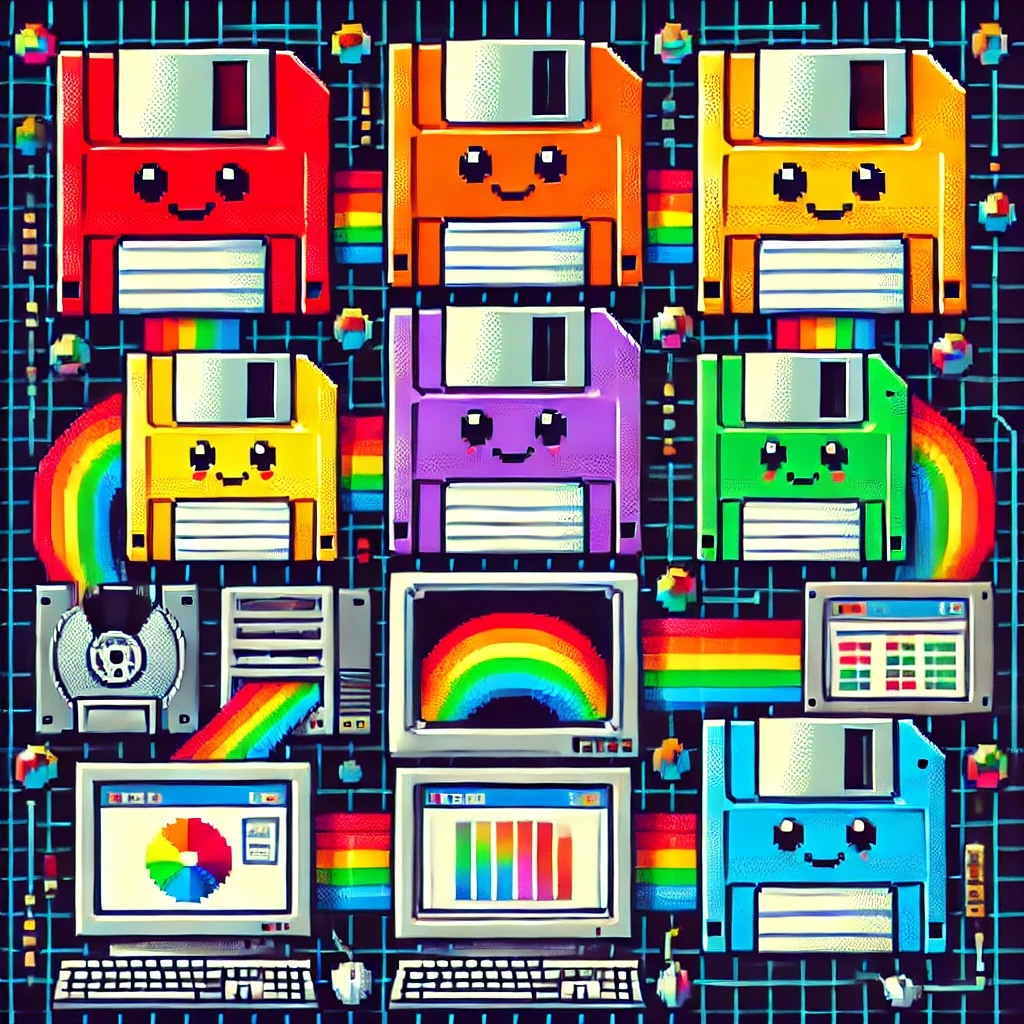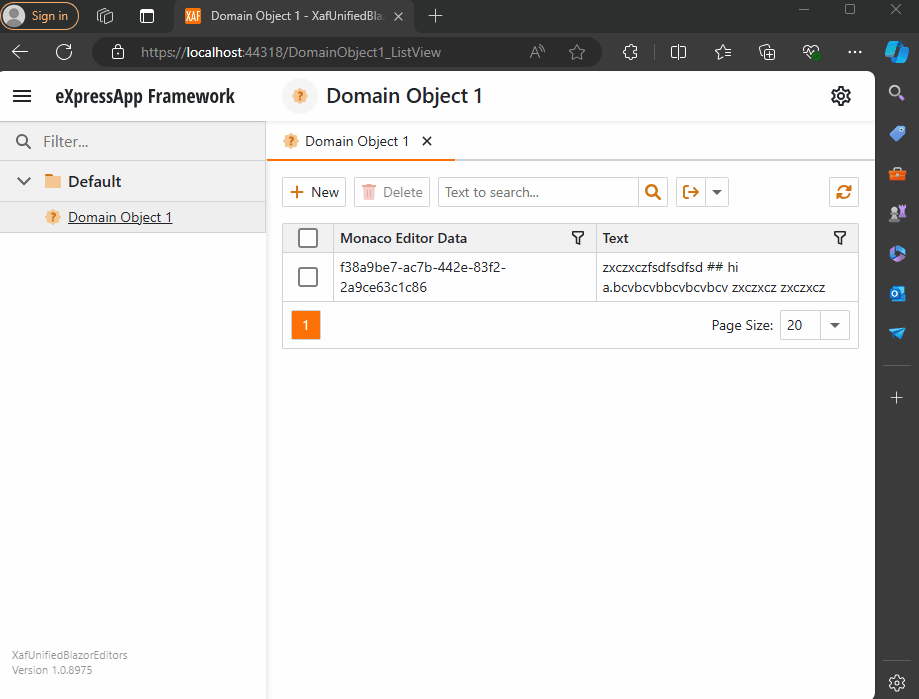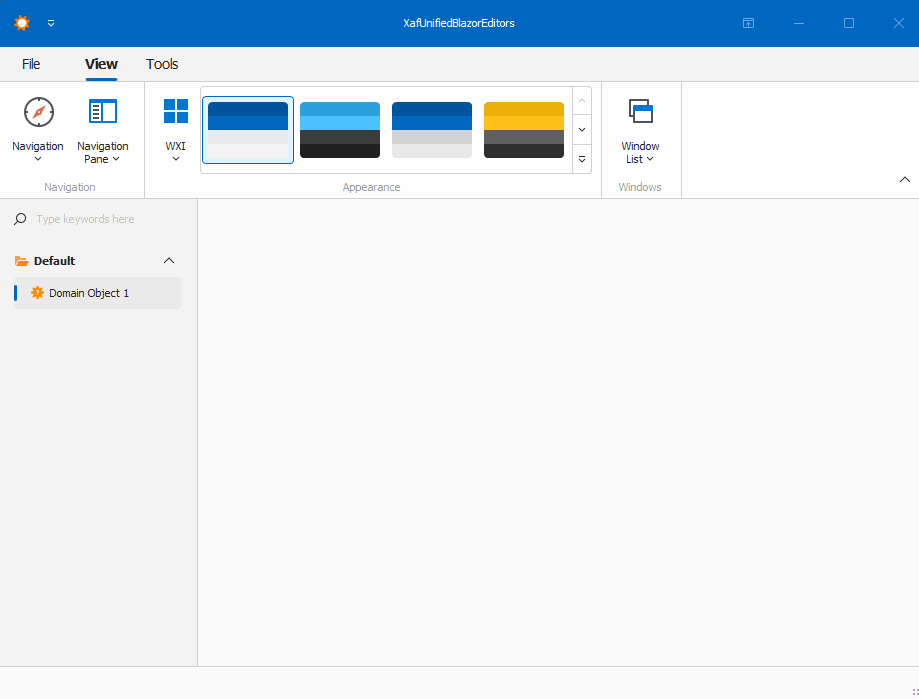
by Joche Ojeda | Sep 4, 2024 | A.I, Semantic Kernel, XPO
In today’s AI-driven world, the ability to quickly and efficiently store, retrieve, and manage data is crucial for developing sophisticated applications. One tool that helps facilitate this is the Semantic Kernel, a lightweight, open-source development kit designed for integrating AI models into C#, Python, or Java applications. It enables rapid enterprise-grade solutions by serving as an effective middleware.
One of the key concepts in Semantic Kernel is memory—a collection of records, each containing a timestamp, metadata, embeddings, and a key. These memory records can be stored in various ways, depending on how you implement the interfaces. This flexibility allows you to define the storage mechanism, which means you can choose any database solution that suits your needs.
In this blog post, we’ll walk through how to use the IMemoryStore interface in Semantic Kernel and implement a custom memory store using DevExpress XPO, an ORM (Object-Relational Mapping) tool that can interact with over 14 database engines with a single codebase.
Why Use DevExpress XPO ORM?
DevExpress XPO is a powerful, free-to-use ORM created by DevExpress that abstracts the complexities of database interactions. It supports a wide range of database engines such as SQL Server, MySQL, SQLite, Oracle, and many others, allowing you to write database-independent code. This is particularly helpful when dealing with a distributed or multi-environment system where different databases might be used.
By using XPO, we can seamlessly create, update, and manage memory records in various databases, making our application more flexible and scalable.
Implementing a Custom Memory Store with DevExpress XPO
To integrate XPO with Semantic Kernel’s memory management, we’ll implement a custom memory store by defining a database entry class and a database interaction class. Then, we’ll complete the process by implementing the IMemoryStore interface.
Step 1: Define a Database Entry Class
Our first step is to create a class that represents the memory record. In this case, we’ll define an XpoDatabaseEntry class that maps to a database table where memory records are stored.
public class XpoDatabaseEntry : XPLiteObject {
private string _oid;
private string _collection;
private string _timestamp;
private string _embeddingString;
private string _metadataString;
private string _key;
[Key(false)]
public string Oid { get; set; }
public string Key { get; set; }
public string MetadataString { get; set; }
public string EmbeddingString { get; set; }
public string Timestamp { get; set; }
public string Collection { get; set; }
protected override void OnSaving() {
if (this.Session.IsNewObject(this)) {
this.Oid = Guid.NewGuid().ToString();
}
base.OnSaving();
}
}
This class extends XPLiteObject from the XPO library, which provides methods to manage the record lifecycle within the database.
Step 2: Create a Database Interaction Class
Next, we’ll define an XpoDatabase class to abstract the interaction with the data store. This class provides methods for creating tables, inserting, updating, and querying records.
internal sealed class XpoDatabase {
public Task CreateTableAsync(IDataLayer conn) {
using (Session session = new(conn)) {
session.UpdateSchema(new[] { typeof(XpoDatabaseEntry).Assembly });
session.CreateObjectTypeRecords(new[] { typeof(XpoDatabaseEntry).Assembly });
}
return Task.CompletedTask;
}
// Other database operations such as CreateCollectionAsync, InsertOrIgnoreAsync, etc.
}
This class acts as a bridge between Semantic Kernel and the database, allowing us to manage memory entries without having to write complex SQL queries.
Step 3: Implement the IMemoryStore Interface
Finally, we implement the IMemoryStore interface, which is responsible for defining how the memory store behaves. This includes methods like UpsertAsync, GetAsync, and DeleteCollectionAsync.
public class XpoMemoryStore : IMemoryStore, IDisposable {
public static async Task ConnectAsync(string connectionString) {
var memoryStore = new XpoMemoryStore(connectionString);
await memoryStore._dbConnector.CreateTableAsync(memoryStore._dataLayer).ConfigureAwait(false);
return memoryStore;
}
public async Task CreateCollectionAsync(string collectionName) {
await this._dbConnector.CreateCollectionAsync(this._dataLayer, collectionName).ConfigureAwait(false);
}
// Other methods for interacting with memory records
}
The XpoMemoryStore class takes advantage of XPO’s ORM features, making it easy to create collections, store and retrieve memory records, and perform batch operations. Since Semantic Kernel doesn’t care where memory records are stored as long as the interfaces are correctly implemented, you can now store your memory records in any of the databases supported by XPO.
Advantages of Using XPO with Semantic Kernel
- Database Independence: You can switch between multiple databases without changing your codebase.
- Scalability: XPO’s ability to manage complex relationships and large datasets makes it ideal for enterprise-grade solutions.
- ORM Abstraction: With XPO, you avoid writing SQL queries and focus on high-level operations like creating and updating objects.
Conclusion
In this blog post, we’ve demonstrated how to integrate DevExpress XPO ORM with the Semantic Kernel using the IMemoryStore interface. This approach allows you to store AI-driven memory records in a wide variety of databases while maintaining a flexible, scalable architecture.
In future posts, we’ll explore specific use cases and how you can leverage this memory store in real-world applications. For the complete implementation, you can check out my GitHub fork.
Stay tuned for more insights and examples!

by Joche Ojeda | Sep 4, 2024 | A.I, Semantic Kernel
In our continued exploration of Semantic Kernel, we shift focus towards its memory capabilities, specifically diving into the Microsoft.SemanticKernel.Memory Namespace. Here, we’ll discuss the critical components that allow for efficient memory management and how you can integrate your own custom memory stores for AI applications. One of the standout implementations within this namespace is the VolatileMemoryStore, but equally important is understanding how any class that implements IMemoryStore can serve as a backend for SemanticTextMemory.
What Is “Memory” in Semantic Kernel?
Before we dive into the technical details, let’s clarify what we mean by “memory” within the Semantic Kernel framework. When we refer to “memory,” we are not talking about RAM or the typical computer memory used to store data for a short period of time. In the context of Semantic Kernel, memory refers to a record or a unit of information, much like a piece of information you might recall from personal experience. This could be an entry stored in a memory store, which later can be retrieved, searched, or modified.
The Microsoft.SemanticKernel.Memory Namespace
This namespace contains several important classes that serve as the foundation for memory management in the kernel. These include but are not limited to:
- MemoryRecord: The primary schema for memory storage.
- MemoryRecordMetadata: Handles metadata associated with a memory entry.
- SemanticTextMemory: Implements methods to save, retrieve, and search for text-based information in a memory store.
- VolatileMemoryStore: A simple, in-memory implementation of a memory store, useful for short-term storage during runtime.
- IMemoryStore: The interface that defines how a memory store should behave. Any class that implements this interface can act as a memory backend for SemanticTextMemory.
VolatileMemoryStore: A Simple Example
The VolatileMemoryStore is an example of a non-persistent memory store. It operates in-memory and is well-suited for temporary storage needs that do not require long-term persistence. The class implements IMemoryStore, which means that it provides all the essential methods for storing and retrieving records in the memory.
Some of its key methods include:
- CreateCollectionAsync: Used to create a collection of records.
- DeleteCollectionAsync: Deletes a collection from the memory.
- UpsertAsync: Inserts or updates a memory record.
- GetAsync: Retrieves a memory record by ID.
- GetNearestMatchesAsync: Finds memory records that are semantically closest to the input.
Given that the VolatileMemoryStore does not offer persistence, it is primarily suited for short-lived applications. However, because it implements IMemoryStore, it can be replaced with a more persistent memory backend if required.
IMemoryStore: The Key to Custom Memory Implementations
The power of the Semantic Kernel lies in its flexibility. As long as a class implements the IMemoryStore interface, it can be used as a memory backend for the kernel’s memory management. This means that you are not limited to using the VolatileMemoryStore. Instead, you can develop your own custom memory stores by following the pattern established by this class.
For instance, if you need to store memory records in a database, or in a distributed cloud storage solution, you can implement the IMemoryStore interface and define how records should be inserted, retrieved, and managed within your custom store. Once implemented, this custom memory store can be used by the SemanticTextMemory class to manage text-based memories.
SemanticTextMemory: Bringing It All Together
At the core of managing memory in the Semantic Kernel is the SemanticTextMemory class. This class interacts with your memory store to save, retrieve, and search for text-based memory records. Whether you’re using the VolatileMemoryStore or a custom implementation of IMemoryStore, the SemanticTextMemory class serves as the interface that facilitates text-based memory operations.
Key methods include:
- SaveInformationAsync: Saves information into the memory store, maintaining a copy of the original data.
- SearchAsync: Allows for searching the memory based on specific criteria, such as finding semantically similar records.
- GetCollectionsAsync: Retrieves available collections of memories from the memory store.
Why Flexible Memory Stores Matter
The flexibility provided by the IMemoryStore interface is critical because it allows developers to integrate the Semantic Kernel into a wide variety of systems, from small-scale in-memory applications to enterprise-grade solutions that require persistent storage across distributed environments. Whether you’re building an AI agent that needs to “remember” user inputs between sessions or a bot that needs to recall relevant details during an interaction, the memory system in the Semantic Kernel is built to scale with your needs.
Final Thoughts
In the world of AI, memory is a crucial component that makes AI agents more intelligent and capable of handling complex interactions. With the Microsoft.SemanticKernel.Memory Namespace, developers have a flexible, scalable solution for memory management. Whether you’re working with the in-memory VolatileMemoryStore or designing your custom memory backend, the IMemoryStore interface ensures seamless integration with the Semantic Kernel’s memory system.
By understanding the relationship between IMemoryStore, VolatileMemoryStore, and SemanticTextMemory, you can harness the full potential of the Semantic Kernel to create more sophisticated AI-driven applications.
Memory Types in Semantic Kernel

by Joche Ojeda | Sep 4, 2024 | A.I, Semantic Kernel
In the world of AI and large language models (LLMs), understanding how to manage memory is crucial for creating applications that feel responsive and intelligent. Many developers are turning to Semantic Kernel, a lightweight and open-source development kit, to integrate these capabilities into their applications. For those already familiar with Semantic Kernel, let’s dive into how memory functions within this framework, especially when interacting with LLMs via chat completions.
Chat Completions: The Most Common Interaction with LLMs
When it comes to interacting with LLMs, one of the most intuitive and widely used methods is through chat completions. This allows developers to simulate a conversation between a user and an AI agent, facilitating various use cases like building chatbots, automating business processes, or even generating code.
In Semantic Kernel, chat completions are implemented through models from popular providers like OpenAI, Google, and others. These models enable developers to manage the flow of conversation seamlessly. While using chat completions, one key aspect to keep in mind is how the conversation history is stored and managed.
Temporary Memory: ChatHistory and Kernel String Arguments
Within the Semantic Kernel framework, the memory that a chat completion model uses is managed by the ChatHistory object. This object stores the conversation history temporarily, meaning it captures the back-and-forth between the user and the model during an active session. Alternatively, you can use a string argument passed to the kernel, which contains context information for the conversation. However, like the ChatHistory, this method is also not persistent.
Once the host class is disposed of, all stored context and memory from both the ChatHistory object and the string argument are lost. This transient nature of memory means that these methods are useful only for short-term interactions and are destroyed after the session ends.
What’s Next? Exploring Long-Term Memory Options
In this article, we’ve discussed how Semantic Kernel manages short-term memory with ChatHistory and kernel string arguments. However, for more complex applications that require retaining memory over longer periods—think customer support agents or business process automation—temporary memory might not be sufficient. In the next article, we’ll explore the options available for implementing long-term memory within Semantic Kernel, providing insights on how to make your AI applications even more powerful and context-aware.
Stay tuned for the deep dive into long-term memory solutions!

by Joche Ojeda | Aug 15, 2024 | network, VPN
In the digital age, protecting one’s online privacy and circumventing internet censorship have become paramount concerns. Two prominent technologies addressing these concerns are Shadow Sockets and Virtual Private Networks (VPNs). While both offer ways to secure internet traffic, they differ significantly in their approach, application, and effectiveness.
What are Shadow Sockets?
Shadow Sockets (Shadowsocks) is an open-source encrypted proxy project, initially developed by a Chinese programmer known as “clowwindy” in 2012. It was created to bypass the Great Firewall of China, which imposes stringent restrictions on internet access. Unlike traditional VPNs, Shadowsocks focuses on bypassing censorship while maintaining a lightweight and high-performance connection.
History of Shadow Sockets
The creation of Shadowsocks was driven by the increasing internet censorship in China. Clowwindy designed Shadowsocks to be a secure and efficient method for users to access the uncensored internet. Over the years, the project has evolved, with numerous contributors enhancing its features and performance. In 2015, clowwindy announced that they had been contacted by Chinese authorities and would no longer be involved in the project. Despite this, the open-source nature of Shadowsocks allowed the community to continue its development, leading to various implementations and forks.
How Shadow Sockets Work
Shadowsocks operates by creating an encrypted tunnel between the user’s device and a proxy server located outside the censored area. This proxy server forwards the user’s internet traffic to its intended destination. Shadowsocks utilizes the SOCKS5 protocol, which ensures that the data passing through is secure and difficult to detect by censorship mechanisms.
Comparison Between Shadow Sockets and Traditional VPNs
Both Shadow Sockets and VPNs aim to secure internet traffic and provide access to restricted content. However, they differ in several key aspects:
1. Technology and Protocols
- VPNs: Traditional VPNs create a secure and encrypted tunnel between the user’s device and a VPN server using protocols like OpenVPN, L2TP/IPsec, or IKEv2. This tunnel encrypts all internet traffic, ensuring that data is secure from eavesdropping and interception.
- Shadowsocks: Shadowsocks uses the SOCKS5 proxy protocol. While it also creates an encrypted tunnel, it focuses on being less detectable by censorship mechanisms. Shadowsocks is designed to resemble regular HTTPS traffic, making it harder to block.
2. Performance
- VPNs: VPNs can sometimes slow down internet connections due to the overhead of encryption and the distance to the VPN server. The performance can vary based on the protocol used and the server’s location.
- Shadowsocks: Shadowsocks is typically faster and more lightweight compared to VPNs. Its design minimizes overhead, resulting in better performance and lower latency, especially useful in high-censorship environments.
3. Censorship Circumvention
- VPNs: While VPNs are effective at bypassing censorship, they can be blocked by advanced firewalls that detect VPN traffic. Countries with strict internet controls, like China and Iran, actively block known VPN servers and protocols.
- Shadowsocks: Shadowsocks excels in bypassing censorship due to its ability to mimic regular HTTPS traffic. This makes it more resilient against detection and blocking by sophisticated firewalls.
4. Use Cases
- VPNs: VPNs are widely used for general privacy protection, secure remote access to networks, and accessing geo-restricted content. They are favored for their ease of use and comprehensive encryption.
- Shadowsocks: Shadowsocks is preferred in environments with heavy censorship, where traditional VPNs are likely to be blocked. It’s often used by users in countries with stringent internet restrictions to access free and open internet.
5. Setup and Configuration
- VPNs: Setting up a VPN typically involves installing a client application and connecting to a server. Many VPN providers offer user-friendly apps for various devices.
- Shadowsocks: Shadowsocks setup can be more complex, often requiring manual configuration of the proxy settings. However, several third-party clients have simplified this process for end-users.
Conclusion
Both Shadow Sockets and traditional VPNs play crucial roles in securing internet traffic and bypassing censorship. However, their differences in technology, performance, and use cases make each suitable for specific scenarios. Shadowsocks, with its ability to evade detection and provide high performance, is particularly valuable in high-censorship environments. On the other hand, VPNs offer comprehensive security and ease of use, making them ideal for general privacy protection and accessing geo-restricted content. Understanding these differences can help users choose the right tool for their specific needs.

by Joche Ojeda | Jul 28, 2024 | PropertyEditors, XAF
Introduction
The eXpressApp Framework (XAF) from DevExpress is a versatile application framework that supports multiple UI platforms, including Windows Forms and Blazor. Maintaining separate property editors for each platform can be cumbersome. This article explores how to create unified property editors for both Windows Forms and Blazor by leveraging WebView for Windows Forms and the Monaco Editor, the editor used in Visual Studio Code.
Blazor Implementation

Windows forms Implementation

Prerequisites
Before we begin, ensure you have the following installed:
- Visual Studio 2022 or later
- .NET 8.0 SDK or later
- DevExpress XAF 22.2 or later
Step 1: Create a XAF Application for Windows Forms and Blazor
- Create a New Solution:
- Open Visual Studio and create a new solution.
- Add two projects to this solution:
- A Windows Forms project.
- A Blazor project.
- Set Up XAF:
- Follow the DevExpress documentation to set up XAF in both projects. Official documentation here
Step 2: Create a Razor Class Library
- Create a Razor Class Library:
- Add a new Razor Class Library project to the solution.
- Name it XafVsCodeEditor.
- Design the Monaco Editor Component:
We are done with the shared library that we will reference in both Blazor and Windows projects.
Step 3: Integrate the Razor Class Library into Windows Forms
- Add NuGet References:
- In the Windows Forms project, add the following NuGet packages:
- Microsoft.AspNetCore.Components.WebView.WindowsForms
- XafVsCodeEditor (the Razor Class Library created earlier).
- You can see all the references in the csproj file.
- Change the Project Type: In order to add the ability to host Blazor components, we need to change the project SDK from Microsoft.NET.Sdk to Microsoft.NET.Sdk.Razor.
- Add Required Files:
- wwwroot: folder to host CSS, JavaScript, and the index.html.
- _Imports.razor: this file adds global imports. Source here.
- index.html: one of the most important files because it hosts a special blazor.webview.js to interact with the WebView. See here.
Official Microsoft tutorial is available here.
Step 4: Implementing the XAF Property Editors
I’m not going to show the full steps to create the property editors. Instead, I will focus on the most important parts of the editor. Let’s start with Windows.
In Windows Forms, the most important method is when you create the instance of the control, in this case, the WebView. As you can see, this is where you instantiate the services that will be passed as a parameter to the component, in our case, the data model. You can find the full implementation of the property editor for Windows here and the official DevExpress documentation here.
protected override object CreateControlCore()
{
control = new BlazorWebView();
control.Dock = DockStyle.Fill;
var services = new ServiceCollection();
services.AddWindowsFormsBlazorWebView();
control.HostPage = "wwwroot\\index.html";
var tags = MonacoEditorTagHelper.AddScriptTags;
control.Services = services.BuildServiceProvider();
parameters = new Dictionary<string, object>();
if (PropertyValue == null)
{
PropertyValue = new MonacoEditorData() { Language = "markdown" };
}
parameters.Add("Value", PropertyValue);
control.RootComponents.Add<MonacoEditorComponent>("#app", parameters);
control.Size = new System.Drawing.Size(300, 300);
return control;
}
Now, for the property editor for Blazor, you can find the full source code here and the official DevExpress documentation here.
protected override IComponentModel CreateComponentModel()
{
var model = new MonacoEditorDataModel();
model.ValueChanged = EventCallback.Factory.Create<IMonacoEditorData>(this, value => {
model.Value = value;
OnControlValueChanged();
WriteValue();
});
return model;
}
One of the most important things to notice here is that in version 24 of XAF, Blazor property editors have been simplified so they require fewer layers of code. The magical databinding happens because in the data model there should be a property of the same value and type as one of the parameters in the Blazor component.
Step 5: Running the Application
Before we run our solution, we need to add a domain object that implements a property of type IMonacoData, which is the interface we associated with our property editor. Here is a sample domain object that has a property of type MonacoEditorData:
[DefaultClassOptions]
public class DomainObject1 : BaseObject, IXafEntityObject
{
public DomainObject1(Session session) : base(session) { }
public override void AfterConstruction()
{
base.AfterConstruction();
}
MonacoEditorData monacoEditorData;
string text;
public MonacoEditorData MonacoEditorData
{
get => monacoEditorData;
set => SetPropertyValue(nameof(MonacoEditorData), ref monacoEditorData, value);
}
[Size(SizeAttribute.DefaultStringMappingFieldSize)]
public string Text
{
get => text;
set => SetPropertyValue(nameof(Text), ref text, value);
}
public void OnCreated()
{
this.MonacoEditorData = new MonacoEditorData("markdown", "");
MonacoEditorData.PropertyChanged += SourceEditor_PropertyChanged;
}
void IXafEntityObject.OnSaving()
{
this.Text = this.MonacoEditorData.Code;
}
void IXafEntityObject.OnLoaded()
{
this.MonacoEditorData = new MonacoEditorData("markdown", this.Text);
MonacoEditorData.PropertyChanged += SourceEditor_PropertyChanged;
}
private void SourceEditor_PropertyChanged(object sender, PropertyChangedEventArgs e)
{
this.Text = this.MonacoEditorData.Code;
}
}
As you can see, DomainObject1 implements the interface IXafEntityObject. We are using the interface events to load and save the content of the editor to the text property.
Now, build and run the solution. You should now have a Windows Forms application that hosts a Blazor property editor using WebView and the Monaco Editor, as well as a Blazor application using the same property editor.
You can find a working example here.
Conclusion
By leveraging WebView and the Monaco Editor, you can create unified property editors for both Windows Forms and Blazor in XAF applications. This approach simplifies maintenance and provides a consistent user experience across different platforms. With the flexibility of Blazor and the robustness of Windows Forms, you can build powerful and versatile property editors that cater to a wide range of user needs.

by Joche Ojeda | Jul 6, 2024 | Uncategorized
AI Integration and Future Plans
El Salvador has embarked on a remarkable journey of technological transformation under the leadership of President Nayib Bukele. Building on the momentum from its pioneering adoption of Bitcoin as legal tender, the nation is now setting its sights on integrating Artificial Intelligence (AI) into various sectors to foster innovation and growth. This article explores President Bukele’s vision for AI, the potential benefits and challenges, and the critical need for establishing robust AI legislation.
Government Vision for AI
President Bukele envisions a future where AI plays a central role in El Salvador’s development. In recent developments, he appointed Brian Roemmele, a renowned expert in voice technology and AI, as an AI advisor. Roemmele’s appointment highlights the government’s commitment to integrating AI to drive economic growth and educational opportunities, positioning El Salvador as a leader in the digital age[7][8][9].
Economic Growth: By fostering an environment conducive to AI innovation, El Salvador aims to attract tech companies and startups, thereby boosting economic growth and creating high-tech job opportunities.
Smart Governance: The integration of AI in government operations promises to enhance efficiency, transparency, and responsiveness, making public administration more effective and citizen-centric[28][30].
Global Competitiveness: Bukele’s vision includes positioning El Salvador as a leader in AI within Latin America, much like its pioneering role with Bitcoin. This involves not only adopting AI technologies but also setting standards that other countries can follow.
Potential Benefits and Challenges
The potential benefits of AI integration are immense:
Economic Benefits: AI can drive significant economic growth by improving productivity, fostering innovation, and creating new job sectors[28][30].
Social Benefits: AI can enhance the quality of life by improving healthcare, education, and public services, leading to a more inclusive and equitable society[27][29].
However, the challenges cannot be overlooked:
Ethical Concerns: Ensuring that AI systems are fair, transparent, and free from bias is crucial to prevent societal harm.
Data Privacy: Protecting the personal data of citizens is essential to maintain trust and prevent misuse.
Workforce Displacement: The transition to an AI-driven economy must be managed carefully to support workers displaced by automation through reskilling and education initiatives.
The Need for AI Legislation
To harness the full potential of AI while addressing its challenges, it is imperative to establish a comprehensive AI legal framework. This framework should cover several key areas:
1. Ethical Standards
- Transparency: AI developers must disclose methodologies and data sources to ensure clarity and trust.
- Accountability: Clear accountability mechanisms for AI decisions, especially in critical sectors like healthcare and finance.
- Fairness: Measures to prevent bias and ensure equitable treatment for all users of AI systems.
2. Data Protection
- Privacy Laws: Strengthened data privacy laws to safeguard citizens’ information.
- Consent: Ensuring individuals have control over their data, including the ability to opt-out of AI data processing.
3. Innovation Incentives
- Research Grants: Funding for AI research and development projects.
- Tax Breaks: Tax incentives for companies investing in AI technologies and infrastructure.
4. Workforce Transition
- Reskilling Programs: Programs to help workers displaced by AI acquire new skills and transition to new job opportunities in the AI sector.
- Education Initiatives: Integrating AI and digital literacy into the national education curriculum.
5. International Cooperation
- Standards Collaboration: Working with international bodies to adopt global AI standards and best practices.
- Regional Partnerships: Fostering regional cooperation in AI research and development.
Conclusion
El Salvador’s journey towards technological transformation continues with the integration of AI. By setting the rules for AI through robust legislation, El Salvador can ensure that it remains at the forefront of innovation in Latin America. The proposed AI legal framework not only addresses the ethical and practical challenges of AI but also positions the country as a leader in the digital future. As El Salvador charts this new course, the commitment to innovation and responsible governance will be key to its success.
This article outlines the government’s vision for AI in El Salvador, the potential benefits and challenges, and the critical need for AI legislation. It aims to inform and engage readers, encouraging them to support and contribute to the country’s digital future.
Related Articles
El Salvador: Digital Transformation Initiatives
El Salvador: The Implementation of Bitcoin as Legal Tender
El Salvador’s Technological Revolution

by Joche Ojeda | Jul 5, 2024 | El Salvador, Uncategorized
Partnerships with Tech Giants
El Salvador has embarked on an ambitious journey of digital transformation, significantly bolstered by strategic partnerships with leading technology companies. These collaborations have been pivotal in advancing the country’s technological landscape across various sectors.
One notable partnership is with Google, focusing on enhancing healthcare, education, and digital government services. Google’s involvement includes the deployment of cloud services to streamline government operations and the integration of AI tools to improve healthcare delivery. Through these initiatives, El Salvador aims to enhance the efficiency and accessibility of public services, ensuring that technology benefits all citizens.
In the education sector, partnerships with tech giants are transforming learning environments. Google Classroom and other digital platforms are being integrated into schools, enabling remote learning and enhancing the quality of education. These tools not only facilitate learning during crises like the COVID-19 pandemic but also prepare students for a digital future.
Development of Digital Infrastructure
Central to El Salvador’s digital transformation is the robust development of digital infrastructure. The government has made significant investments to ensure widespread internet access, recognizing it as a cornerstone for digital inclusion. Efforts include expanding broadband coverage to rural areas and implementing 5G technology in urban centers.
Digital payment systems have also seen substantial growth. The introduction of the Chivo Wallet, a government-backed digital wallet, marked a significant step in promoting cashless transactions. This initiative aligns with the broader goal of fostering a digital economy and reducing the reliance on traditional banking systems. Moreover, the Chivo Wallet’s integration with Bitcoin and other cryptocurrencies opens new avenues for financial inclusion and innovation.
E-government platforms are another critical component of this transformation. The government has launched various online portals to streamline public services, from tax filing to business registrations. These platforms not only enhance efficiency but also reduce bureaucratic hurdles, making it easier for citizens and businesses to interact with the government.
Efforts to Improve Digital Literacy
Recognizing that technological advancements are only as effective as the population’s ability to use them, El Salvador has prioritized digital literacy. The government, in collaboration with educational institutions and private sector partners, has launched comprehensive programs aimed at improving digital skills across the population.
For the general public, initiatives include community training programs and digital literacy campaigns. These efforts focus on teaching basic computer skills, internet navigation, and the safe use of digital tools. By equipping citizens with these skills, the government aims to ensure that everyone can participate in the digital economy and access online services.
In the education sector, digital literacy is being integrated into the national curriculum. Schools are now equipped with modern technology, and teachers receive training on digital teaching methods. This approach not only prepares students for future job markets but also fosters a culture of innovation and technological proficiency from a young age.
Government employees are also a focus of digital literacy efforts. Specialized training programs have been developed to enhance the digital skills of public sector workers. These programs aim to improve the efficiency of government operations and ensure that public servants can effectively use new technologies in their daily tasks.
Conclusion
El Salvador’s digital transformation under President Nayib Bukele is a multifaceted effort encompassing strategic partnerships, infrastructure development, and comprehensive digital literacy programs. By working with tech giants like Google, investing in digital infrastructure, and prioritizing digital education, the country is laying a strong foundation for a technologically advanced future. These initiatives not only improve the quality of life for Salvadorans but also position the country as a leader in digital innovation within Latin America. As El Salvador continues to embrace digital transformation, it serves as a compelling case study for other nations seeking to navigate the complexities of the digital age.
Related Articles
El Salvador: The Implementation of Bitcoin as Legal Tender
El Salvador’s Technological Revolution

by Joche Ojeda | Jul 4, 2024 | Bitcoin, El Salvador
Background
Before delving into the specifics of Bitcoin’s adoption, it’s crucial to understand the economic landscape of El Salvador. Historically, the country has faced significant economic challenges, including high poverty rates, limited access to financial services, and a heavy reliance on remittances, which account for about 20% of its GDP. Since 2001, El Salvador has used the US dollar as its official currency, which has provided stability but also limited monetary policy options for the government.
Bitcoin Law
On June 9, 2021, El Salvador made headlines worldwide by becoming the first country to adopt Bitcoin as legal tender. The Bitcoin Law, proposed by President Nayib Bukele and swiftly passed by the Legislative Assembly, mandates that Bitcoin must be accepted as a form of payment by all businesses and allows it to be used for all debts, public or private. The law’s key provisions include:
- Mandatory Acceptance: All economic agents must accept Bitcoin as payment when offered by the buyer.
- Tax Contributions: Tax contributions can be paid in Bitcoin.
- Pricing: Prices can be expressed in Bitcoin.
- Exchanges: Exchanges between Bitcoin and the US dollar will be exempt from capital gains tax.
- Government Support: The government will promote the necessary training and mechanisms so that the population can access Bitcoin transactions.
The initial public response was mixed. While some saw it as a groundbreaking move to modernize the economy, others were skeptical about the volatility of Bitcoin and its potential impacts on everyday transactions.
Implementation
The implementation of Bitcoin involved several key steps:
- Chivo Wallet: The government developed the Chivo Wallet, a digital wallet that allows users to store and transact in Bitcoin and US dollars. To incentivize adoption, each user who signed up received $30 worth of Bitcoin.
- Bitcoin ATMs: A network of Bitcoin ATMs was established across the country to facilitate the exchange between Bitcoin and US dollars.
- Government Investments: The Salvadoran government made several Bitcoin purchases, intending to stabilize the market and show confidence in the new system.
Despite initial technical glitches and skepticism, the government continued to promote Bitcoin adoption through educational campaigns and infrastructure development.
Impact
Economic Impact
- Financial Inclusion: Bitcoin has provided an opportunity for financial inclusion, particularly for the unbanked population. With around 70% of Salvadorans lacking access to traditional banking services, Bitcoin offers an alternative means of participating in the economy.
- Remittances: The use of Bitcoin for remittances has the potential to reduce transaction fees and speed up transfer times, benefiting many Salvadoran families who rely on money sent from abroad.
- Investment and Tourism: The Bitcoin initiative has attracted international attention, potentially boosting tourism and foreign investment. The country has seen a surge in crypto-related tourism, with enthusiasts visiting to experience a Bitcoin-driven economy firsthand.
Social Impact
- Education and Awareness: The push for Bitcoin has necessitated widespread educational efforts to ensure that the population understands how to use and benefit from digital currency. This has sparked broader discussions about financial literacy and digital technologies.
- Public Sentiment: Public opinion remains divided. While some embrace the innovation, others fear the volatility of Bitcoin and the implications for price stability and everyday transactions.
Conclusion
El Salvador’s bold move to adopt Bitcoin as legal tender marks a significant milestone in its technological transformation. While the long-term effects are still unfolding, this initiative positions the country at the forefront of digital currency adoption. The next steps involve addressing the challenges of volatility, continuing to educate the population, and monitoring the broader economic impacts. As the world watches, El Salvador’s experiment with Bitcoin will provide valuable lessons for other nations considering similar paths.
Related Articles
El Salvador’s Technological Revolution

by Joche Ojeda | Jul 3, 2024 | A.I, Blockchain, El Salvador
El Salvador, my birthplace, has recently emerged as a focal point for technological innovation under the leadership of President Nayib Bukele. Born in Suchitoto during the civil war and now living as a digital nomad in Saint Petersburg, Russia, I have witnessed El Salvador’s transformation from a distance and feel compelled to share its story. This article is the first in a series exploring how blockchain technology, financial services, and artificial intelligence (AI) can help a small country like El Salvador grow.
Historical Context and Economic Challenges
El Salvador has faced significant economic challenges over the past few decades, including poverty, gang violence, and a heavy reliance on remittances from abroad. The economy has traditionally been rooted in agriculture, with coffee and sugar being key exports. However, President Bukele, who took office on June 1, 2019, has sought to address these challenges by diversifying the economy and embracing technology as a key driver of growth.
Bukele’s Vision for Economic Transformation
President Bukele’s administration has prioritized technological innovation as a catalyst for economic transformation. His vision is to modernize the country’s infrastructure and position El Salvador as a hub for technological innovation in Latin America. This vision includes the strategic shift from an agriculture-based economy to one focused on technology, financial services, and tourism. The goal is to create a more resilient and diverse economic base that can sustain long-term growth and development.
The Adoption of Bitcoin as Legal Tender
One of the most groundbreaking moves by Bukele’s administration was the introduction of the Bitcoin Law, passed by the Legislative Assembly on June 9, 2021. This law made Bitcoin legal tender alongside the US dollar, which had been the country’s official currency since 2001. The rationale behind this decision was multifaceted:
- Financial Inclusion: With a significant portion of the population lacking access to traditional banking services, Bitcoin offers an alternative means of financial inclusion.
- Reduction in Remittance Costs: Remittances make up a substantial part of El Salvador’s economy. Bitcoin’s adoption aims to reduce the high transaction fees associated with remittance services.
- Economic Innovation: By adopting Bitcoin, El Salvador aims to attract foreign investment and position itself as a leader in cryptocurrency and blockchain technology.
The implementation of Bitcoin involved launching the Chivo Wallet, a state-sponsored digital wallet designed to facilitate Bitcoin transactions. The government also incentivized adoption by offering $30 worth of Bitcoin to citizens who registered for the wallet.
Initial Reactions and Impact
The reaction to the Bitcoin Law was mixed. While some praised the move as innovative and forward-thinking, others raised concerns about the volatility of Bitcoin and its potential impact on the economy. Despite these concerns, the Bukele administration has remained committed to its Bitcoin strategy, continuing to invest in Bitcoin and integrate it into the national economy.
Digital Transformation Initiatives
I
n addition to Bitcoin adoption, El Salvador has partnered with global tech giants like Google to enhance its digital infrastructure. These partnerships aim to modernize government services, improve healthcare through telemedicine platforms, and revolutionize education by integrating AI-driven tools. For instance, Google’s collaboration with the Salvadoran government includes training government agencies on cloud technologies and developing platforms that allow interoperability between institutions.
Strategic Shift to Technology, Financial Services, and Tourism
President Bukele’s broader economic strategy involves shifting El Salvador’s economic focus from traditional agriculture to more dynamic and sustainable sectors like technology, financial services, and tourism. This shift aims to create high-value jobs, attract foreign investment, and build a more diversified economy.
- Technology: By investing in digital infrastructure and fostering a favorable environment for tech startups, El Salvador aims to become a regional tech hub.
- Financial Services: The adoption of Bitcoin and other fintech innovations is intended to transform the financial landscape, making it more inclusive and efficient.
- Tourism: Enhancing the country’s tourism sector, with initiatives to promote its natural beauty and cultural heritage, is another key pillar of Bukele’s economic strategy.
Conclusion and Future Prospects
El Salvador’s journey towards becoming a technological leader in Latin America is a testament to the transformative power of visionary leadership and innovative policies. Under President Bukele, the country has taken bold steps to embrace technology, from adopting Bitcoin to integrating AI into public services. This series of articles will delve deeper into these initiatives, exploring their impact, challenges, and the future prospects for El Salvador in the global technological landscape.
By understanding El Salvador’s technological revolution, we can gain insights into the potential for other nations to leverage technology for economic and social development. The next article in this series will focus on the detailed implementation of Bitcoin as legal tender, examining the steps taken by the Bukele administration and the outcomes observed so far.
This introductory article sets the stage for a comprehensive exploration of El Salvador’s technological transformation under President Bukele. The subsequent articles will provide in-depth analyses and propose potential AI legislation to ensure the country’s continued leadership in technology within Latin America.

by Joche Ojeda | Jul 3, 2024 | Uncategorized
Hey there, fellow developers! Today, let’s talk about a practice that can revolutionize the way we create, test, and perfect our software: dogfooding. If you’re wondering what dogfooding means, don’t worry, it’s not about what you feed your pets. In the tech world, “eating your own dog food” means using the software you develop in your day-to-day operations. Let’s dive into how this can be a game-changer for us.
Why Should We Dogfood?
- Catch Bugs Early: By using our own software, we become our first line of defense against bugs and glitches. Real-world usage uncovers issues that might slip through traditional testing. We get to identify and fix these problems before they ever reach our users.
- Enhance Quality Assurance: There’s no better way to ensure our software meets high standards than by relying on it ourselves. When our own work depends on our product, we naturally aim for higher quality and reliability.
- Improve User Experience: When we step into the shoes of our users, we experience firsthand what works well and what doesn’t. This unique perspective allows us to design more intuitive and user-friendly software.
- Create a Rapid Feedback Loop: Using our software internally means continuous and immediate feedback. This quick loop helps us iterate faster, refining features and squashing bugs swiftly.
- Build Credibility and Trust: When we show confidence in our software by using it ourselves, it sends a strong message to our users. It demonstrates that we believe in what we’ve created, enhancing our credibility and trustworthiness.
Real-World Examples
- Microsoft: They’re known for using early versions of Windows and Office within their own teams. This practice helps them catch issues early and improve their products before public release.
- Google: Googlers use beta versions of products like Gmail and Chrome. This internal testing helps them refine their offerings based on real-world use.
- Slack: Slack’s team relies on Slack for communication, constantly testing and improving the platform from the inside.
How to Start Dogfooding
- Integrate it Into Daily Work: Start by using your software for internal tasks. Whether it’s a project management tool, a communication app, or a new feature, make it part of your team’s daily routine.
- Encourage Team Participation: Get everyone on board. The more diverse the users, the more varied the feedback. Encourage your team to report bugs, suggest improvements, and share their experiences.
- Set Up Feedback Channels: Create dedicated channels for feedback. This could be as simple as a Slack channel or a more structured feedback form. Ensure that the feedback loop is easy and accessible.
- Iterate Quickly: Use the feedback to make quick improvements. Prioritize issues that affect usability and functionality. Show your team that their feedback is valued and acted upon.
Overcoming Challenges
- Avoid Bias: While familiarity is great, it can also lead to bias. Pair internal testing with external beta testers to get a well-rounded perspective.
- Manage Resources: Smaller teams might find it challenging to allocate resources for internal use. Start small and gradually integrate more aspects of your software into daily use.
- Consider Diverse Use Cases: Remember, your internal environment might not replicate all the conditions your users face. Keep an eye on diverse scenarios and edge cases.
Conclusion
Dogfooding is more than just a quirky industry term. It’s a powerful practice that can elevate the quality of our software, speed up our development cycles, and build stronger trust with our users. By using our software as our customers do, we gain invaluable insights that can lead to better, more reliable products. So, let’s embrace the dogfood, turn our critical eye inward, and create software that we’re not just proud of but genuinely rely on. Happy coding, and happy dogfooding! ??
Feel free to share your dogfooding experiences in the comments below. Let’s learn from each other and continue to improve our craft together!









